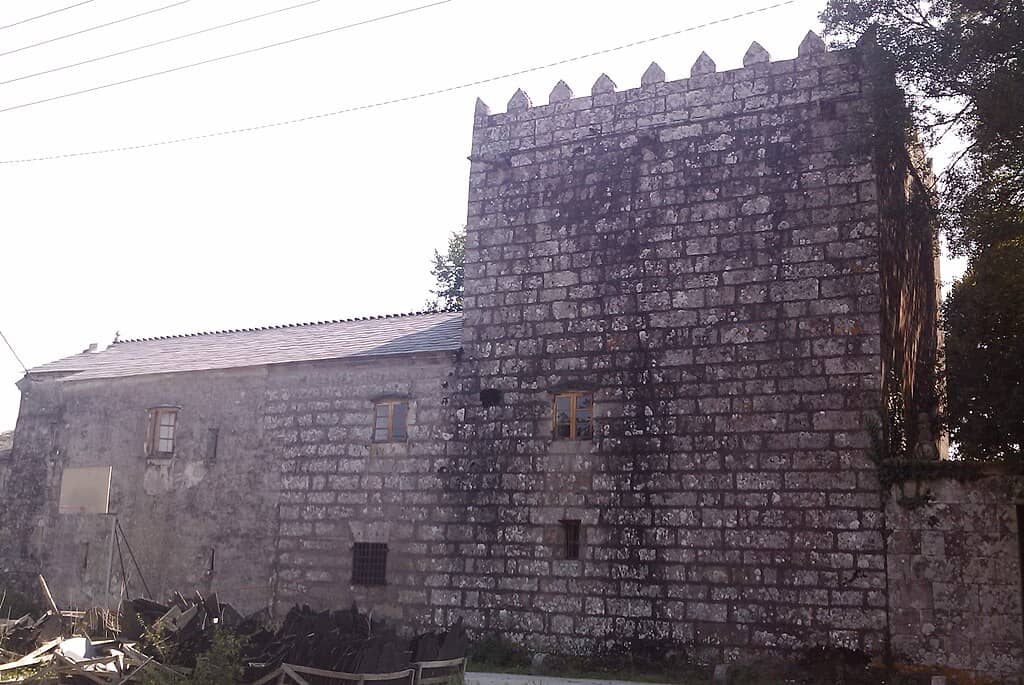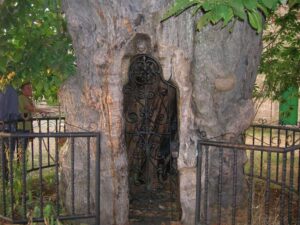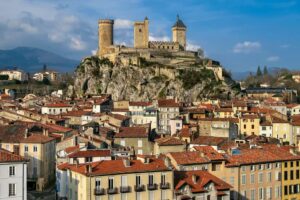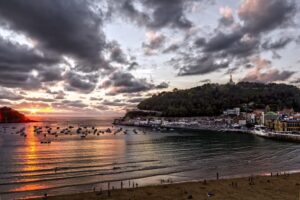
Miraz is a small village in the province of Lugo, nestled in the heart of the Camino de Santiago del Norte. With only about 40 inhabitants, this hamlet offers pilgrims a peaceful haven between stages, perfect for resting and experiencing the rural essence of Galicia.
First, we’ll tell you what makes the Northern Way unique compared to other Jacobean routes. After that, we’ll explore what to see in Miraz and its surroundings, focusing on the pilgrim who seeks history, nature, and local traditions.
Índice de contenidos
Why choose the Northern Way? A comparison of Jacobean routes
As you may know, there are multiple routes to reach the Cathedral of Santiago, each with its own personality. The choice depends on what the pilgrim is looking for: from popularity and services to the solitude of less-travelled paths. The Northern Way, in particular, has gained followers due to its coastal landscapes and authenticity. Here are some reasons to choose this route over others:
- Spectacular coastal landscapes: it runs along the Cantabrian Sea for much of its course, offering views of wild beaches, cliffs, and fishing ports. Iconic sections such as the Camino de Santiago from Santander to Gijón allow you to discover charming seaside towns, alternating mountains and coast in a green, wet environment very different from the more inland routes.
- Less crowded and more authentic: unlike the heavily trafficked French Way (the most popular Jacobean route), it receives fewer pilgrims. This results in quieter stages, less crowded villages, and a greater sense of authenticity.
For those seeking an introspective experience and a deeper connection with their surroundings, this route is ideal. It’s not empty, but it does offer more spaces of solitude and silence compared to the main routes.
- Moderate physical challenge and variety of terrains: its profile combines flat sections with others that involve steep ascents and descents, offering an intermediate physical challenge. It doesn’t have the mountainous toughness of the Primitive Way, but it requires more preparation than the flat Silver Way or the Castilian plateau of the French Way.
The reward is a wide variety of ecosystems in just a few kilometres: Atlantic forests, rural paths, beaches, and coastal hills. Each stage is different, keeping the pilgrim’s interest day after day.
- Alternative cultural heritage: along the Cantabrian coast, it passes through cities and cultural landmarks of great interest. From San Sebastián and Bilbao in the Basque Country, through Santander and Gijón on the Cantabrian coast, to hidden monasteries in Galicia.
This route allows you to discover a different side of northern Spain, with Basque, mountain, Asturian, and Galician influences. Romanesque churches, mansions of emigrants, ancient pilgrim hospitals, and other treasures dot the route.
Of course, each alternative has its charm:
- The French Way offers the best infrastructure of services, as well as a very social atmosphere; it’s ideal for those who value the constant company of other pilgrims.
- The Primitive Way is the oldest and most challenging, immersing the walker in spectacular mountain landscapes and solitude.
- The Portuguese Way, the second most popular route, offers the Atlantic warmth of Portugal and southern Galicia. In fact, the Portuguese Way has two main variants: the inland route (which many start in Tui) and the coastal route. The latter starts in the city of Porto and stays close to the ocean throughout.
Many pilgrims enjoy the Portuguese Coastal Way, which runs from Porto to the Spanish border. For example, the section of the Portuguese Way from Porto to A Guarda follows the entire northern coast of Portugal with seafaring landscapes, and then connects with Galicia. From there, the Way from A Guarda to Santiago crosses the Rías Baixas of Galicia.
Ultimately, there is no “better” route, just the one that best suits your preferences. If you dream of the sea, green landscapes, and a less crowded experience, the route we’re discussing is an excellent choice. And if you prefer other environments, the alternatives are there, each with its own personality.
Whichever you choose, it’s important to plan the journey well. Many pilgrims manage everything themselves, but there are also many specialised agencies in Camino de Santiago trips that handle accommodation, luggage transport, and other services. They allow the pilgrim to focus solely on enjoying the Way.
Miraz: a stop on the Northern Way full of history and calm
Miraz is located approximately halfway between Baamonde and Sobrado dos Monxes, in the province of Lugo. For the pilgrim walking this section, it’s an important stop: many choose to overnight here to break up the long stage and regain strength before continuing.
Although it’s a small and humble place, it has several heritage gems and a lot of rural charm. Upon arrival, the pilgrim encounters the most authentic Galicia: scattered stone houses, green fields, oak and eucalyptus forests, and a peaceful atmosphere that invites contemplation.
Points of interest in Miraz and the surrounding area:
Tower and Pazo of Miraz

On the outskirts of the village stands an imposing medieval tower with a square floor plan, a relic of an ancient feudal fortress. Its origin dates back to the 15th century, when it was part of the Saavedra family’s possessions, later passing into the hands of the Andrade family in the same century.
This crenellated tower, about 12 metres high, displays heraldic shields of Galician lineages on its walls, reminding visitors of the time when feudal lords controlled these lands. Attached to the tower is an 18th-century manor house, built in a simple style with a corridor supported by columns.
Currently, the entire property is privately owned and serves as a residence, so it can only be viewed from the outside. Nevertheless, its silhouette transports visitors centuries back in time, making it probably the most notable historical monument in the locality.
For history enthusiasts, there is another interesting spot nearby: the Fortaleza de San Paio de Narla, an ancient medieval castle that houses the provincial ethnographic museum of Lugo. This 13th-16th-century fortification offers a glimpse into the life of Galician nobility and contains valuable historical pieces.
Church of Santiago

The small parish church, dedicated to Saint James, is another essential stop for pilgrims. Built of solid granite stone, this rural construction stands out for its simple traditional Galician architecture and the belfry (wall-mounted bell tower) that crowns its façade.
In the church’s atrium, there is a cruceiro (stone cross) dated 1962, a typical symbol of the Galician paths representing spirituality and divine protection at crossroads. To one side of the church, the small local cemetery surprises visitors with the beauty of its old tombstones and neo-Gothic pinnacles, reflecting the devotion and deep-rooted Catholic faith in this community.
Many pilgrims take the opportunity to stamp their credential here.
Chapel of San Pedro
Along with the main church, the village has a humble chapel dedicated to Saint Peter. It is a small and rustic chapel, with its greatest treasure being an ancient carving of the Virgin of the Rosary that presides over its interior. This simple Virgin image has accompanied the locals in their prayers for generations.
The construction dates back to the 15th century, making it another fragment of the historical past that survives in the village. It is often found closed outside of festive dates, but its exterior already conveys the spiritual and traditional atmosphere of the place.
Natural surroundings and tranquillity
Beyond specific monuments, the main attraction of Miraz is Miraz itself: its calm atmosphere and natural surroundings. The village is surrounded by meadows, low hills, and native forests dominated by oaks and chestnuts, with a few streams scattered around.
After so many days of walking, many pilgrims enjoy simply strolling around the area at sunset, watching the golden light fall over the Galician fields. There are no large infrastructures or urban noises; time seems to move more slowly. This lack of rush and mass tourism allows one to integrate with the environment, connecting with the rural essence of Galicia.
The sounds accompanying one’s stay are usually the songs of birds, the wind through the trees, the crowing of an early rooster, or the friendly greeting of a neighbour. This direct contact with nature and the simple life of the countryside is, for many, one of the most cherished memories of their time here.
It is worth mentioning that Miraz has a very unique pilgrims’ hostel: the Albergue de la Confraternity of St. James, run by a British brotherhood. This small refuge, with a limited capacity for just over a dozen people, was rehabilitated thanks to English volunteers.
Gastronomy and local traditions in Miraz
Although Miraz does not have luxurious restaurants or a wide range of gastronomic offerings (there is barely a bar-shop that serves as a social meeting point), pilgrims can taste authentic Galician homemade cuisine on this stretch of the Camino.
In the small villages of Galicia, gastronomy is deeply connected to the land and tradition. The dishes are simple but comforting, ideal after a long walk. It is common for locals, when asked, to offer a hearty bowl of caldo gallego (hot soup made with turnip greens, potatoes, and beans) during the cold season, or a freshly made empanada (Galician pastry).
The local products are the foundation of everything: handmade bread baked in a wood-fired oven, local cheeses, vegetables from the garden, free-range eggs, and meats from nearby livestock. In fact, the municipality of Friol (to which Miraz belongs) is famous for its Arzúa-Ulloa cheese, made in a traditional way, and for its pan de Ousá, a large traditional bread with a soft crumb.
Every March, Friol celebrates the Feira do Queixo e do Pan de Ousá, a gastronomic fair where these typical cheeses and breads can be tasted, accompanied by wine and other local delicacies.
As for festivals, the village, like many Galician parishes, honours its patron saints with annual celebrations.
- In mid-July, the festivities in honour of Virxe do Carme (Our Lady of Mount Carmel) and Apóstol Santiago take place in Miraz.
- During a weekend close to 25th July (Saint James’ Day), the village organises solemn masses, followed by the traditional vermú session (music and dance at midday) and evening parties.
Another deeply rooted custom in rural Galicia is its hospitality.Here, the pilgrim is not an anonymous tourist, but someone welcomd by the local community. It is likely that in the village bar or at the fountain while refilling water, the locals will strike up a conversation with the visitors, ask where they come from, or wish them “¡Bo Camiño!” (Good Camino) with a smile.
There are even solidarity initiatives in nearby stages (for example, in the neighbouring village of Carballedo, there is a pilgrim support point run by local volunteers) that demonstrate the selfless generosity towards the walkers.
Miraz may not have large monuments or luxuries, but it offers what many pilgrims value: authenticity, intimate history, nature, and human warmth. Its medieval tower and church speak of the past; its trails through forests bring peace; its festivals and flavours bring us closer to the most genuine Galicia.
For the pilgrim wondering what to see in Miraz, the answer lies in the small details: a sunset walk along its rural paths, a chat with a neighbour in the only bar, the sight of the Church of Santiago at dawn, or simply resting the body under the same sky that sheltered so many ancient pilgrims.
Miraz is a tiny point on the map of the Northern Way, but it leaves a lasting impression on anyone who takes the time to discover it. You will continue your journey to Santiago with its stamp on your credential and, most likely, with a special fondness for this humble corner that, without great pretensions, has earned a place in your Camino memory. ¡Buen Camino!









